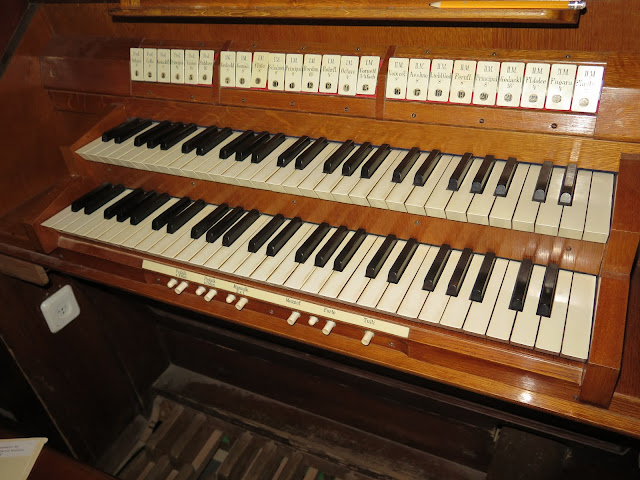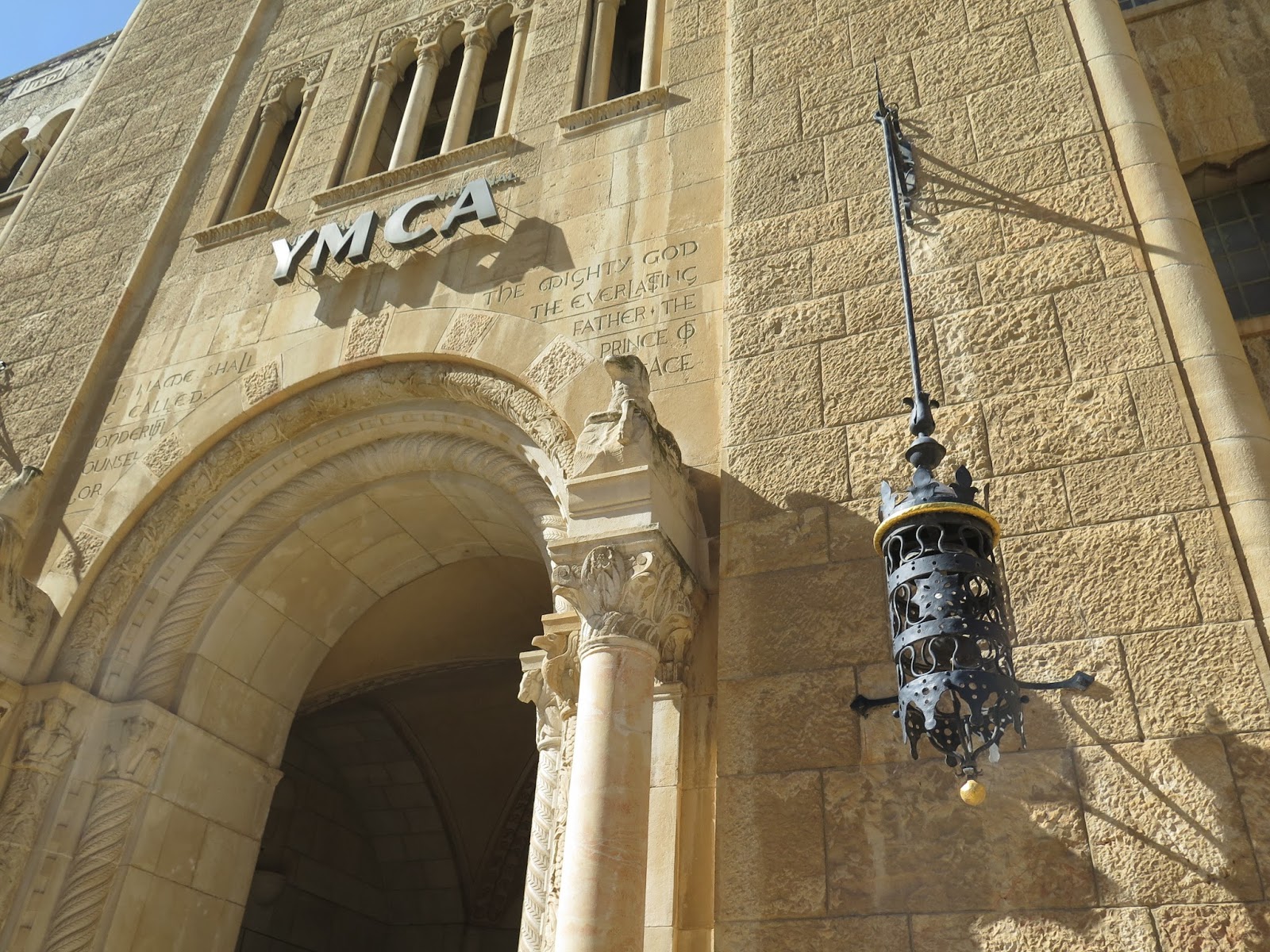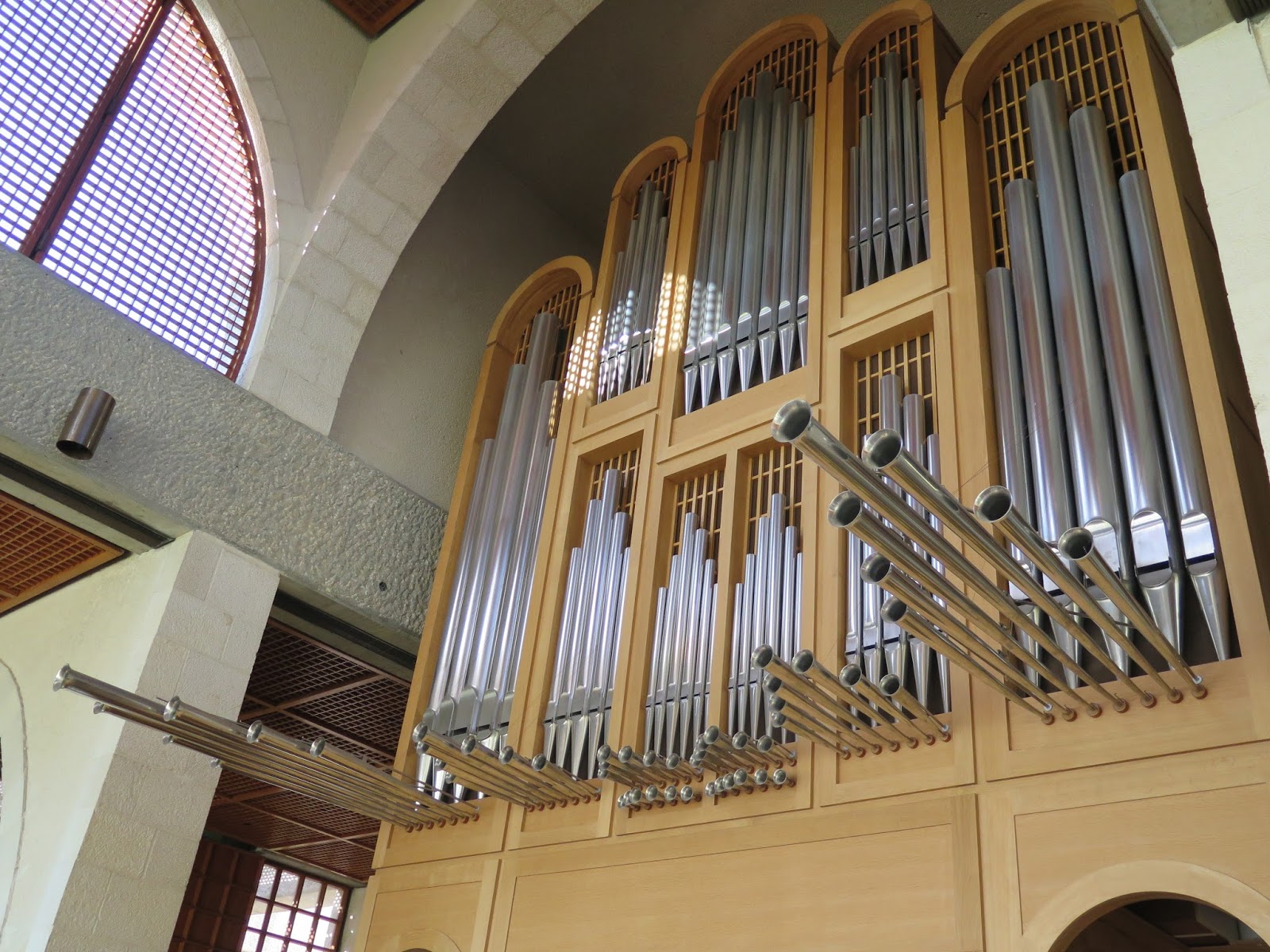One of the things on my "bucket list" has been to play as many organs possible while living in Israel. It's been fun to play each one no matter the size "just because."
Very close to the Jerusalem Center is the organ at the chapel of the Augusta Victoria hospital. Known as the "Church of the Ascension," it is the property of the German Lutheran Church. It was built by Sauer in 1910 and is a romantic Germany organ unique in its type in the Middle East. It is located on the central gallery of the church nave.
The case is made of dark oak. I have been fortunate to have the opportunity to play it twice.
I keep saying, "Every day I learn something new!" Well, I have to laugh because after we left, I learned that even though the original foot blower still exists and is operational, the organ was electrified long ago. Hmm . . . wish I had known that both times I played! (Are you laughing now?)
The organ has 23 stops which include five 16's and twelve 8's. Except for the Cornet and Schalmei 8' of the Great division, all of the stops of this organ are foundations and flutes. The acoustics of the church are very impressive -- about 5 seconds.
The ceilings of the Church of the Ascension are exquisite.
This lovely print of Jesus on a donkey graces the wall on the 2nd level near the organ.
The mosaic floors are beautiful!
On the right side of the nave was a cabinet with some very old Bibles.
In contrast to the organ at the Church of the Ascension, Brent and Marybeth Jones took us to meet organ builder, Gideon Meir, when we first arrived in Israel. We went to see his organ workshop located in Shamir-Rosner, a small city close to Tel Aviv. We were fascinated to meet him and learn it takes him a full year to make one organ. Gideon is 80 and wants to retire and has an apprentice he is training to continue the work he has loved for so many years of his life.
Gideon demonstrated his skill as an organist on his homemade organ then let me play it.
Gideon showed us around his workshop and explained how he makes each individual pipe out of various metal alloys.
However, the most fun I had was when Gideon let me play
this very small organ he made for his grandchildren.
A small generator provided the power.

The Church of the Redeemer is located in the Old City. I had been to this church on several occasions and met the organist, Gunther Goettshe from Germany. He was kind enough to allow me to play one Monday afternoon.


Looking out from the entry into the Church of the Redeemer. As you can see, the church has shops all around it.

The high arches of this church makes the acoustics wonderful . . . a 5 second delay.


The organ has 15 ranks and two keyboards.
The beauty and grand design of the church is even more impressive from the alley that leads from the Zion gate. A German monk, Brother Simeon, met us at the front of the church and showed us the two organs inside.
A spiral staircase lead to the organ loft and the gallery, from where two of the church's four towers are accessible.
The Domition Abbey Church organ was made to fit the exact measurements of the central gallery of the church. It was made by the German firm Oberlinger and there are five sixteen foot pipes. The circular form of the church creates some acoustical problems as some of the sounds have a tendency to interfere with each other.
The stops of the back-organ division are in a separate case made of white oak and the whole main case is made of white oak and being much closer to the public attending the concerts, they can be heard much more distinctly than the others and can be used as soloists. The Swell division shades are made of plexiglass.
Brother Simeon plays for the services and is a self taught organist. He was very friendly and recently came for a tour through the Jerusalem Center where I played. This organ was by inaugurated in 1980.
It is always fun to play different organs. It needed tuning but was a very nice instrument.
Photo below: As we look down from the organ loft, you can see off to the right of the name three of the six small chapels in the church.
Photo below: As we look down from the organ loft, you can see off to the right of the name three of the six small chapels in the church.
On the right side of the choir was a very small organ. As we looked down from the organ loft, we could see a much smaller organ placed to the right of the choir of the church. It is used for the accompaniment of the everyday liturgy and is made of pine in a modern style.
Small as it is, I was anxious to play this little organ with only two manuals instead of three.
The floor of the church is decorated with the symbols of the Zodiac, names of Prophets, and a verse from Proverbs 8, 23-25 written on its circumference.
From the church are two spiral staircases that lead down to the crypt of Virgin Mary. The crypt is a round or rotunda type room located in a level under the church. In the center of the crypt (surrounded by six pillars) is a sculpture of Mary's deathbed, made of ivory and cherry wood. Visitors light up candles near the sculpture.
This painting on the ceiling shows Mary at her deathbed.
We are leaving the church now. It was a wonderful place to visit and to play yet another organ in Israel.

Dormition Abbey is a very impressive structure.
The monastery of Our Lady of the Assumption.
The monastery of Our Lady of the Assumption was closed but this lovely nun allowed us to visit the small church on the property.
This was a small church but the inside was painted with beautiful mosaic patterns. When examining the designs very closely, we realized that none of the designs were truly mosaics, but only painted squares to look like mosaics. It was a beautiful little chapel and we were amazed at the many paintings on the walls and ceilings.
It certainly looks like mosaic but the design on the
ceiling was hand-painted.
I never pass up the chance to play an organ and even though it was small and electric, it was fun to play. Music invites a feeling of reverence in churches and knowing I am able to contribute to that is satisfying to me.

As we were walking out of the little church, I spotted this stained glass window.
The International YMCA
In the basement of this historic building is a very small chapel where we
take the students after we have finished playing the Carillon.
I am always fascinated with the star on the ceiling of the chapel in the basement.
Just when I was not expecting it, I found this tiny pump organ in the basement of the YMCA. We take our students to sing a couple of songs after we play the carillon on Sundays.
Ah ha . . . I knew there had to be an organ under that covering!! This is a very small pump organ and must date back to the early part of the 20th century . . . too bad it wouldn't play.
And while we are speaking about the YMCA, perhaps we can use our imagination and say that the carillon is a "type" of organ? After all, it has a keyboard so I feel it fits into the category so I am counting it as one!
Here is a photo just to prove I have played it!
 |
| The Jerusalem Center auditorium has a spectacular view of Jerusalem. |
The design of this hall by architect Reznik is remarkable on many respects and a feast for the eyes. The organ was inaugurated in 1987. It was checked for intonation and tuning in 1992 by Marcussen. The two organ cases are made of ash wood very elegant in the simplicity of their modern style. The horizontal Chamade Trumpet on front of the case adds to the beauty of the instrument. The organ is maintained in excellent condition.
Made by the Marcussen Organ company in Denmark, it took two years to make . . . one year in Denmark and then it was shipped unassembled to Israel where it took another year to complete. The company is a family business that began 7 generations ago.
This beautiful instrument, donated by an anonymous donor to the Brigham Young University, was constructed by the Danish organ-builder Marcussen. It is installed in the upper part of the amphi-theatrically built main hall and boasts 3,165 pipes!
August 12th will be my last opportunity to perform in a special evening program for the Jerusalem Center students, service couples and professors. As the time draws near, I become emotional just thinking about leaving my position on the organ bench.
For the past 18+ months, I have had the privilege to play recitals for tours three days each week, for Sabbath services on Saturdays and for other very special programs. It has been such a profound experience and one that will be forever etched in my memory.
 I am so thankful for the gift of music and for such great opportunities to share my music. As I write this entry, my eyes are well up with emotion. However, I can leave knowing that I have given it my best efforts to live up to the standard set by the wonderful organists who have preceded me. I will list each of their names at the conclusion of this entry.
I am so thankful for the gift of music and for such great opportunities to share my music. As I write this entry, my eyes are well up with emotion. However, I can leave knowing that I have given it my best efforts to live up to the standard set by the wonderful organists who have preceded me. I will list each of their names at the conclusion of this entry.
 I am so thankful for the gift of music and for such great opportunities to share my music. As I write this entry, my eyes are well up with emotion. However, I can leave knowing that I have given it my best efforts to live up to the standard set by the wonderful organists who have preceded me. I will list each of their names at the conclusion of this entry.
I am so thankful for the gift of music and for such great opportunities to share my music. As I write this entry, my eyes are well up with emotion. However, I can leave knowing that I have given it my best efforts to live up to the standard set by the wonderful organists who have preceded me. I will list each of their names at the conclusion of this entry.
I have played for some pretty important people who have visited the Jerusalem Center on tour. Some have even sat on the bench with me! What a privilege it has been to serve and share the talent I have worked so many years to perfect. Music has been my life and is the fabric of my being.
ORGANISTS WHO
HAVE SERVED SINCE 1988:
Elizabeth Roloff 3 months (Jan. 87 – April 88)
Norma Horton 39 months (April 88 – July 91)
Robert Cundick 24 months (Dec. 91
- Dec.93)
Judith Parker 6
months (Dec. 93 - Dec.
93)
Ethelyn Peterson 24 months (June 94 – June 96)
Robert Evans 18 months (June
96 – Dec. 98)
Parley Belnap 18 months (Dec.
98 – June 99)
Joan Stevens 19 months (June 99 – Jan. 01)
Elise Richards 4 months (Jan. 01 – May 01)
Carol Sumpter 14 months (Sept.
01 – Nov. 02)
Gaile Clark 13 months (June
02 – July 03)
Lewis Phelps 12 months (Oct.
02 – Nov. 03)
Martha Ballantyne 18 months (Dec. 03 – June 04)
Norman Squires 15 months (June
04 – Sept. 05) 1st time
Michael Moody 19 months (Sept. 06 – Oct. 07)
Robert Galbraith 12 months (Oct. 07 – Oct. 08)
Norman Squires 13 months (April
08 – May 09) 2nd time
Walter Whipple 16 months (May
09 – Aug. 10)
Mike Ohman 18 months (Aug. 10 – Feb. 12)
Norman Squires 12 months (Feb. 12 – Feb. 13) 3rd time
Janice Clayton 18 months (Feb.
13 – Aug. 14)
Marybeth Jones 18 months (Aug.
14 – Feb. 16)
Kathleen Holyoak 18+ months (Jan. 16 – Aug. 17)
Janice Clayton My replacement
(Aug. 17 - Jan. 18) 2nd time




































































You've had so many lovely experiences. You've played several I haven't played but missed a couple I did play. If you have time, ask Inna to take you to play the Rieger at St. George. The largest, most impressive organ in Jerusalem is in St. Savior's church. It has even more pipes than the JC organ and was also built by Rieger. Back in the day you contacted Father Armando to play it. Not sure if he is still there. Gunther and his wife look good. It will be a pleasure to see them again.
ReplyDeletethank you so very much for sharing your love and talent of music and the history of jerusalem.. you have taken us on a historical and beautiful trip to Israel that we would not have been able to go any other way .You and Garth are very special to us. May you continue to be blessed.
ReplyDelete